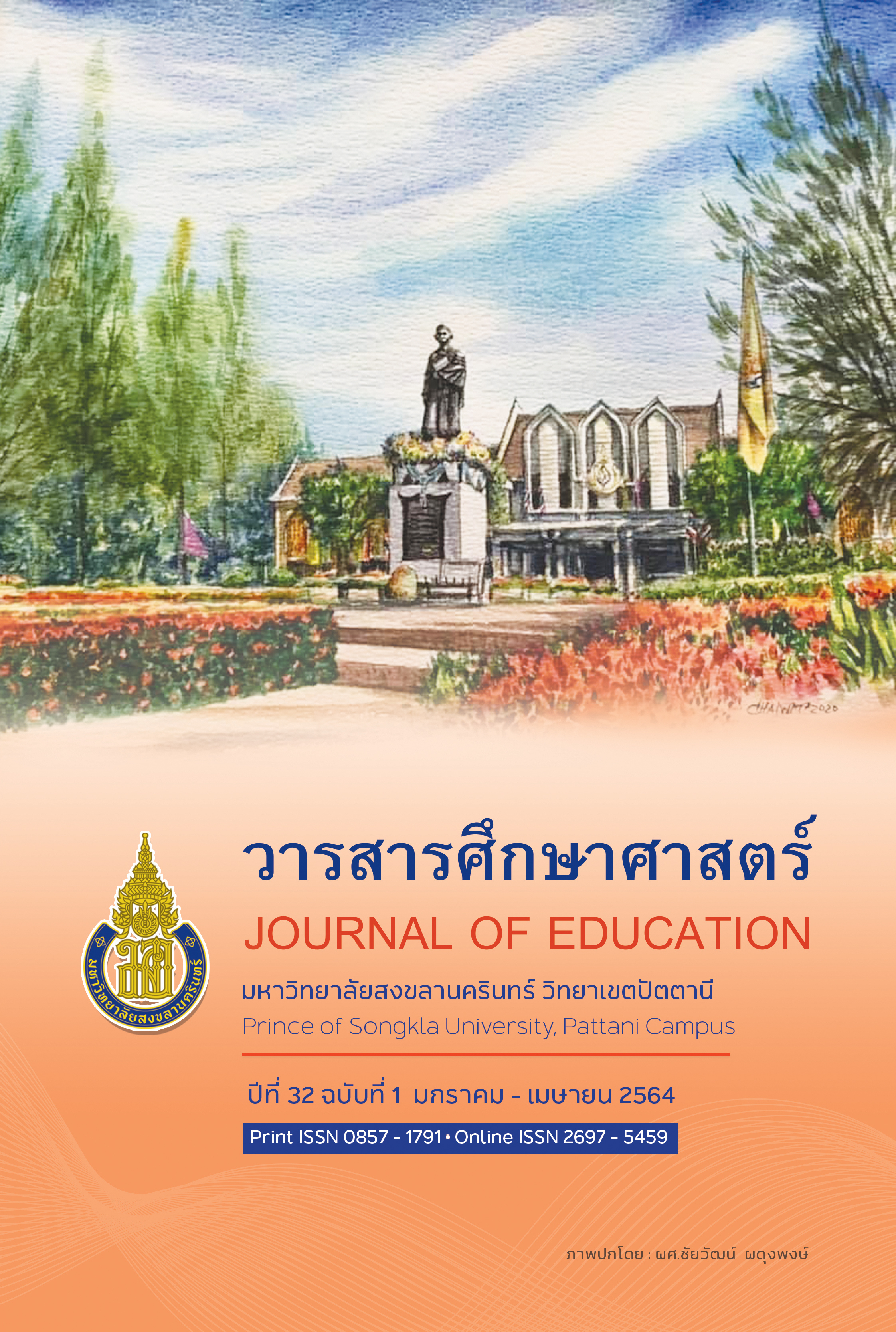การศึกษาความสัมพันธ์ระหว่างความสามารถด้านการพูดภาษาอังกฤษและความเต็มใจในการสื่อสารในห้องเรียนแบบกลับด้านตามความสามารถของผู้เรียนระดับปริญญาตรี
Main Article Content
บทคัดย่อ
งานวิจัยนี้มีวัตถุประสงค์เพื่อศึกษาความสัมพันธ์ระหว่างความสามารถด้านการพูดภาษาอังกฤษและความเต็มใจในการสื่อสารหลังการสอนพูดโดยใช้วิธีการสอนแบบกลับด้านตามความสามารถของผู้เรียน ประชากรที่ใช้ในงานวิจัยนี้คือนักศึกษาระดับปริญญาตรีชาวไทยที่ลงทะเบียนเรียนในรายวิชาภาษาอังกฤษเพื่อการสื่อสารทางวิชาชีพ ชั้นปีที่ 2-4 จำนวน 245 คน โดยกลุ่มตัวอย่างคือ นักศึกษาจากคณะอุตสาหกรรมเกษตร จำนวน 30 คน โดยใช้กลุ่มตัวอย่างที่มีอยู่แล้วตามสภาพธรรมชาติ (Intact Sampling) ใช้ระยะเวลา 12 สัปดาห์ ในการทดลองสอนและเก็บข้อมูลการจัดการเรียนการสอนในงานวิจัยนี้มีทั้งการเรียนผ่านการใช้สื่อออนไลน์นอกห้องเรียนและการเรียนในชั้นเรียนควบคู่กันไป เนื้อหาและกิจกรรมมีการออกแบบให้เหมาะกับความสนใจ ความสามารถ และรูปแบบการเรียนรู้และทำกิจกรรมตามความถนัดของผู้เรียน รวมทั้งออกแบบให้ตอบสนองต่อตัวแปรแบบสถานการณ์ที่มีผลต่อความเต็มใจในการสื่อสาร ได้แก่ ความสามารถด้านการสื่อสาร ความมั่นใจในตนเอง คู่สนทนา หัวข้อสนทนา และบริบทการสนทนา เครื่องมือที่ใช้ในการเก็บข้อมูลคือแบบสอบถามความเต็มใจในการสื่อสารและแบบทดสอบความสามารถด้านการพูด สถิติที่ใช้วิเคราะห์ข้อมูลคือ ค่าสัมประสิทธิ์สหสัมพันธ์แบบเพียร์สัน ผลการศึกษาพบว่าไม่มีความแตกต่างอย่างมีนัยสำคัญทางสถิติที่ระดับ .05 แต่มีความสัมพันธ์ไปในทางบวก ระหว่างความสามารถด้านการพูดและความเต็มใจในการสื่อสาร ดังนั้น จึงสรุปได้ว่านักศึกษาระดับปริญญาตรีชาวไทยที่มีคะแนนความสามารถด้านการพูดสูงอาจไม่มีความเต็มใจในการสื่อสาร และในทางกลับกัน นักศึกษาที่มีระดับความเต็มใจในการสื่อสารสูงอาจไม่มีคะแนนความสามารถด้านการพูดสูงเช่นกัน งานวิจัยนี้ยังได้เสนอข้อเสนอแนะเชิงวิชาการเพื่อการนำไปปรับใช้ในชั้นเรียนและในงานวิจัยต่อไป
Article Details
เอกสารอ้างอิง
Alipour, S. (2018). The effect of engagement in social networking application on Iranian EFL learners’ willingness to communicate in English. Global Journal of Foreign Language Teaching. 8. 165-178.
Allen, T. (2002). Charting a communicative pathway: Using assessment to guide curriculum development in a revitalized general education plan. Communicative Education, 51(1).
Bashir, M. (2011). Factor affecting students’ English-speaking skills. British Journal of Arts and Social Sciences. 2(1). 34-48.
Bashir, M., Azeem, M., Ashiq, D., & Dogar, H. (2011). Factor Effecting Students' English Speaking Skills. British Journal of Arts and Social Sciences. 2(1). 34-50.
Blaz, D. (2016). Differentiated instruction: A Guide for World Language Teachers. (2nd ed.). NY Routledge.
Borja, L. A., Soto, S.T., Sanchez, T. X. (2015). Differentiated instruction for EFL learners. International journal of humanities and social science, 5(8). 30-36.
Carbaugh, E. M., & Doubet, K. J. (2016). The Differentiated flipped classroom: A practical guide to digital learning. CA. Corwin: SAGE Publications.
Chotipaktanasook, N. (2014). Enhancing learners' willingness to communicate in English with social media. Dhurakit Pundut University. Retrieved from https://www.dpu.ac.th/dpurc/assets/uploads/public/jemq7fsotjk80s48ck.pdf
Cockrum, T. (2014). Flipping Your English Class to Reach All Learners: Strategies and Lesson Plans. NY. Routledge.
Creswell, J.W. (2014). Determine Size Using Sample Size Tables. In Creswell, J.W., Educational Research: Planning, Conducting, and Evaluating Quantitative and Qualitative Research (pp. 635-637). ESSEX. Pearson Education.
Gerstein, J. (2011). The Flipped Classroom Model: A Full Picture. Retrieved from https://usergeneratededucation.wordpress.com/2011/06/13/the-flipped-classroom-model-a-full-picture/
Goh, C. C. M. (2007). Teaching speaking in the language classroom. RELC: Singapore
Harmer, J. (2015). How to teach English. (11th ed.). ESSEX. Pearson Education.
Kang, S.-J. (2005). Dynamic Emergence of Situational Willingness to Communicate in a Second Language. System, 33(2), 277-292.
Khan, S. M. (2015). Influence of Speech Anxiety on Oral Communication Skills among ESL/EFL Learners. Advances in Language and Literary Studies, 6(6). 49-53.
Li, V. (2017). Social Media in English Language Teaching and Learning. International Journal of Learning and Teaching. 3(2). 148-153.
MacIntyre, P., Babin, P., & Clément, R. (1999). Willingness to communicate antecedents & consequences. Communication Quarterly. 47(2). 215-229.
MacIntyre, P. D., Dörnyei, Z., Clément, R., & Noels, K. D. (1998). Conceptualizing willingness to communicate in a L2: A situational model of L2 confidence and affiliation. The Modern Language Journal, 82(4). 545-562.
Matsuoka, R. (2004). Willingness to communicate in English among Japanese college students. PAAL Japan. Retrieved from http://www.paaljapan.org/resources/proceedings/2004/Matsuoka.pdf
Mystkowska-Wiertelak A., Pawlak M. (2016). Designing a Tool for Measuring the Interrelationships between L2 WTC, Confidence, Beliefs, Motivation, and Context. In: Pawlak M. (eds). Classroom-Oriented Research. Second Language Learning and Teaching. Springer, Cham.
Pattapong, K. (2010). Willingness to Communicate in a Second Language: A Qualitative Study of Issues Affecting Thai EFL Learners from Students' and Teachers' Point of View. [Doctoral Thesis, University of Sydney]. Sydney: New South Wales.
Pattapong, K (2015). Complex Interactions of Factors Underlying Thai EFL Learners' Willingness to Communicate in English. PASAA: Journal of Language Teaching and Learning in Thailand. 49(1). 105-136.
Rahmatollahi, M. & Khalili, G., F. (2015). Relationship between Intermediate EFL Learners' Communication Apprehension, Willingness to Communicate, and Speaking Ability. International Journal of Applied Linguistics & English Literature. 4(6). 23-32.
Reinders, H., & Wattana, S. (2014). Can I say something? The Effects of Digital Game Play on Willingness to Communicate.Language Learning & Technology, 18(2). 101-123.
Roehl, A., Reddy, S.L. & Shannon, G.J. (2013). The Flipped Classroom: An Opportunity to Engage Millennial Students through Active Learning Strategies. Journal of Family and Consumer Sciences, 105(2). 44-49.
Thornbury, S. (2013). How to Teach Speaking. ESSEX. Pearson Education Limited.
Tomlinson, C. A. (2017). How to differentiate instruction in academically diverse Classrooms. (3rd ed.). VA. Association for Supervision and Curriculum Development (ASCD)


